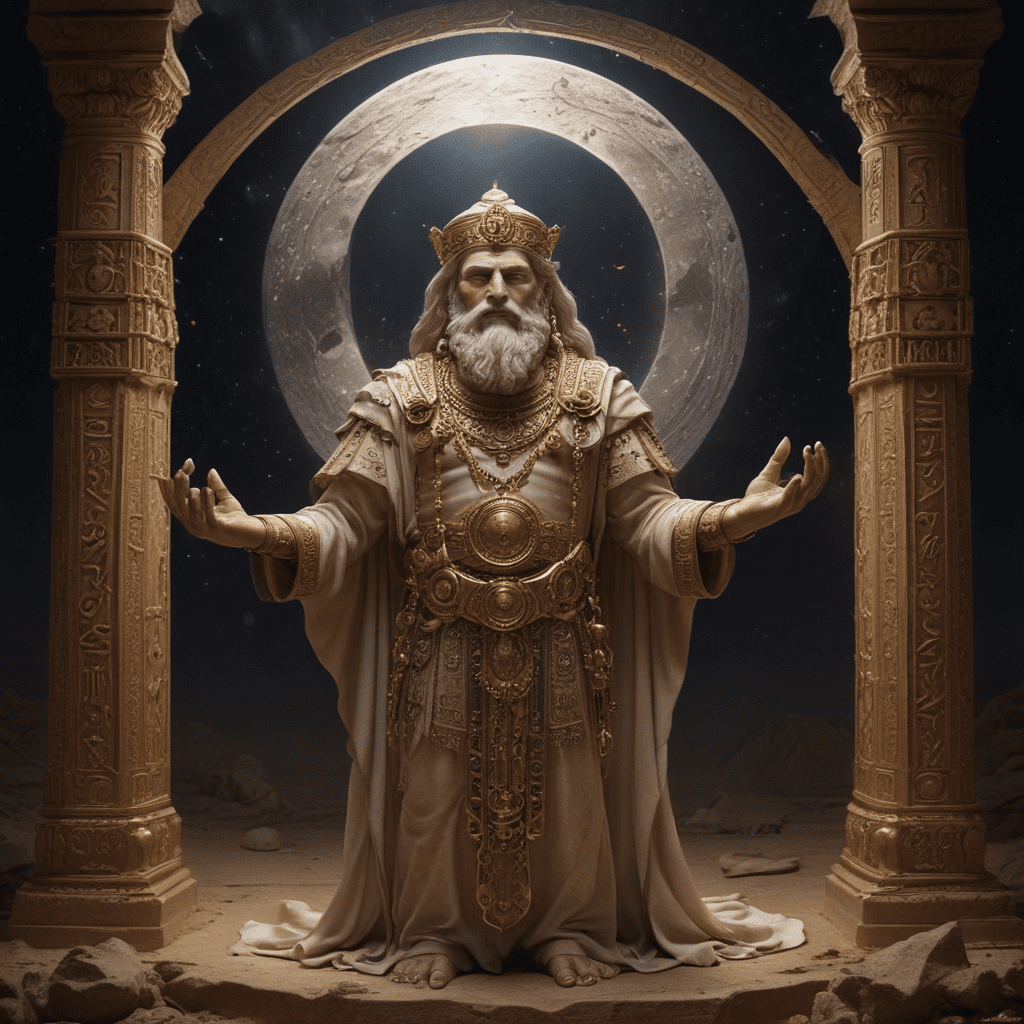Introduction
Mesopotamian religion, a complex and polytheistic belief system, dominated the ancient world for centuries. Within its vast pantheon resided Sin, the revered moon god who held immense significance in Mesopotamian culture. The moon, a celestial body of immense power and mystery, was deeply intertwined with Sin's worship, reflecting the Mesopotamians' profound understanding of the cosmos and their reverence for its celestial forces.
The Mythology of Sin
Sin's origin story is rooted in the Enuma Elish, the Babylonian creation myth. Born from the primordial waters, Sin emerged as the son of the sky god Anu and the earth goddess Ki. He is often depicted as a bearded man adorned with a crescent moon, symbolizing his celestial domain. Sin's influence extended beyond the heavens, as he was also associated with the underworld, believed to be the realm of the dead. He played a crucial role in the fate of human souls, guiding them through their journey in the afterlife.
The Cult of Sin
The worship of Sin flourished in various Mesopotamian cities, with Ur and Harran emerging as prominent centers of his cult. In Ur, the majestic ziggurat known as the E-kishnugal served as Sin's earthly abode, a towering testament to his divine status. Devotees offered sacrifices and prayers to Sin, seeking his protection and blessings. Priests and priestesses, intermediaries between the divine and the mortal, played a pivotal role in maintaining the rituals and traditions associated with Sin's worship.
The Significance of Sin
Sin was revered as a protector and provider, ensuring the well-being of his followers. His association with fertility and agriculture was paramount, as the moon's cycles were believed to influence the growth of crops and the prosperity of the land. Moreover, Sin was perceived as a symbol of time and change, reflecting the cyclical nature of life and the ever-changing phases of the moon.
Theories about the Cult of Sin
The origins of the Cult of Sin remain shrouded in some mystery. Theories suggest that its roots may lie in the ancient Sumerian civilization, where the moon god Nanna was worshipped as a powerful deity. As Mesopotamian culture evolved, Sin's prominence grew, becoming an integral part of the pantheon. The decline of his cult is attributed to the rise of other deities and the gradual shift in religious beliefs.
6. The Significance of Sin
The worship of Sin held profound significance in Mesopotamian society, extending far beyond mere religious observance. His role as a protector and provider instilled a sense of security and trust among his followers, who believed in his ability to safeguard their well-being and ensure their prosperity. Farmers, in particular, revered Sin for his association with fertility and agriculture. The moon's cyclical phases were believed to influence the growth of crops, and Sin's blessings were sought for abundant harvests.
Furthermore, Sin's association with the underworld imbued him with an aura of mystery and power. The Mesopotamians believed that he played a crucial role in the fate of human souls after death, guiding them through the treacherous journey to the afterlife. Sin's influence extended to the realm of health and well-being, as he was believed to have the power to heal the sick and protect the vulnerable.
7. The Legacy of Sin
Although the Cult of Sin declined with the rise of other deities and the gradual shift in religious beliefs, its legacy continued to influence Mesopotamian culture for centuries. The moon remained a prominent symbol in art and literature, representing the cyclical nature of time and the ever-changing phases of life. The stories and myths associated with Sin provided a rich tapestry of cultural heritage, shaping Mesopotamian beliefs about the cosmos, the afterlife, and the human condition.
8. Theories about the Cult of Sin
The origins of the Cult of Sin remain a subject of ongoing scholarly debate. Some theories suggest that its roots may lie in the ancient Sumerian civilization, where the moon god Nanna was worshipped as a powerful deity. As Mesopotamian culture evolved, Sin's prominence grew, becoming an integral part of the pantheon. The decline of his cult is attributed to the rise of other deities, such as Marduk, and the gradual shift in religious beliefs.
9. Conclusion
The Cult of Sin played a significant role in shaping Mesopotamian religion and culture. Sin, the revered moon god, was associated with protection, fertility, health, and the underworld, reflecting the Mesopotamians' profound understanding of the cosmos and their reverence for its celestial forces. Although the cult declined over time, its legacy continues to influence our understanding of Mesopotamian beliefs and practices.
10. FAQ
What were the main rituals associated with the Cult of Sin?
The main rituals associated with the Cult of Sin included offerings, prayers, and festivals. Devotees offered sacrifices of animals and agricultural products to Sin, seeking his protection and blessings. Priests and priestesses played a crucial role in maintaining the rituals and traditions associated with his worship. Festivals and celebrations were held in Sin's honor, often coinciding with the phases of the moon.
What were the major centers of worship for Sin?
The major centers of worship for Sin included Ur and Harran. In Ur, the majestic ziggurat known as the E-kishnugal served as Sin's earthly abode, a towering testament to his divine status. Harran also emerged as a prominent center of Sin's cult, with a temple dedicated to him that became a renowned pilgrimage site.
What was the significance of the moon in Mesopotamian culture?
The moon held immense significance in Mesopotamian culture, as it was believed to influence the growth of crops, the tides, and human destiny. The moon god Sin was associated with the moon's cycles, and his worship reflected the Mesopotamians' profound understanding of the cosmos and their reverence for its celestial forces.




